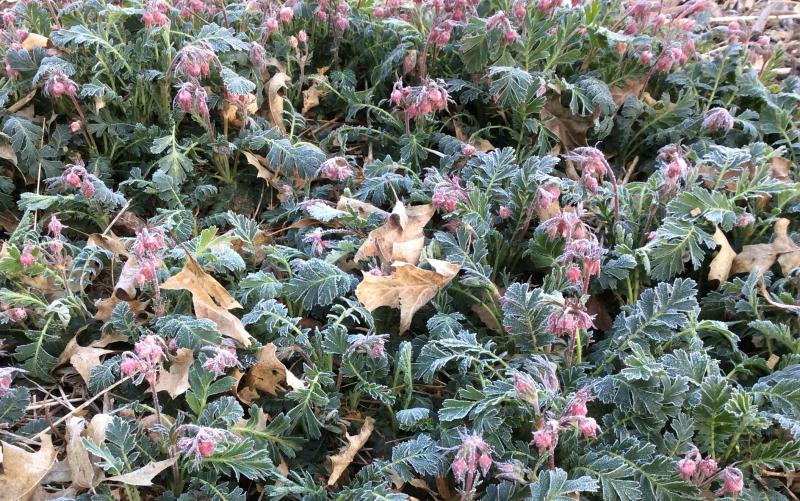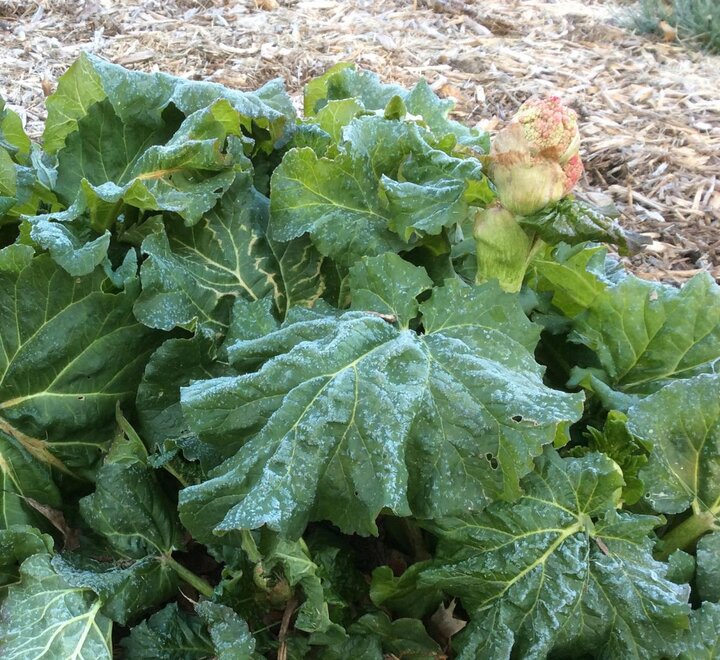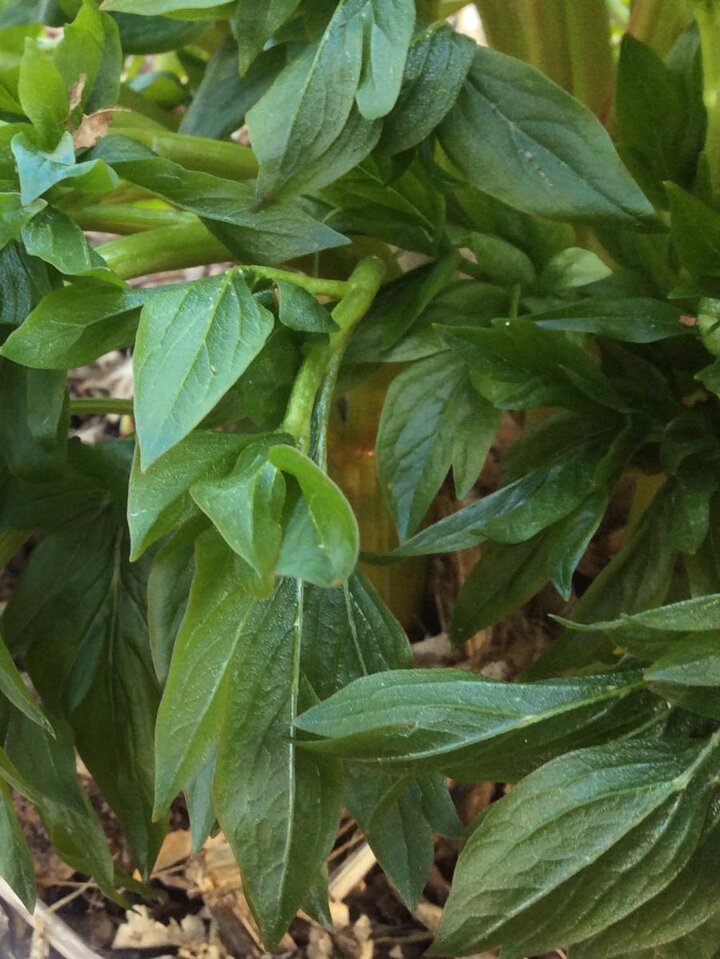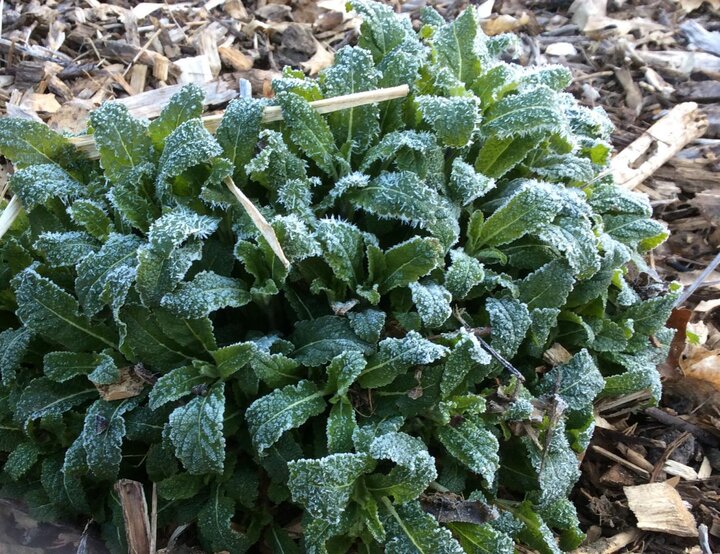
Frost on Prairie Smoke flowers, Geum triflorum. Image by Sarah Browning, Extension Educator
Lincoln may have dodged a bullet! Unseasonably warm, mid-70 to nearly 90-degree temperatures in early April lured trees, shrubs and perennials out of dormancy. Many trees and shrubs have been blooming for the last two weeks, only to be threatened by normal late April frosts.
- April 14-15, Lincoln nighttime temperatures dip to 27°F and 26°F degrees, respectively.
- April 19-21, had nighttime temperatures of31°F, 32°F degrees and 29°F, respectively.
Fortunately, temperatures in Lincoln may not have been low enough to cause serious damage, but surrounding areas of Lincoln weren’t so lucky. Nighttime temperatures for April 22 were 24°F in Mead.
Gardeners always have concerns following a spring freeze. What should you look for to determine if plants were damaged?

One way to determine the likelihood of damage to early season perennials is to look at the cold tolerance of early spring vegetables, which are actively growing during the same time frame.
- Very hardy - Can withstand freezing temperatures and hard frost (less than 28° F) for short periods without injury. Asparagus, collards, endive, kale, kohlrabi, lettuce, mustard, pea, potato, rhubarb, rutabaga, salsify, spinach, turnip.
- Frost tolerant - Can withstand light frosts (32-28° F) without injury. Beet, broccoli, Brussels sprout, cabbage, carrot, cauliflower, celeriac, celery, chard, Chinese cabbage, Jerusalem artichoke, onion, parsnip, radish.


Did you plant potatoes on Good Friday? Potato foliage exposed to freezing temperatures becomes cupped, tattered and distorted, appearing very similar to herbicide damage.
Can rhubarb and asparagus exposed to cold temperatures still be eaten? If either rhubarb or asparagus stalks were damaged by cold, they will turn soft and mushy and eventually become brown; damaged stalks should be pulled out and discarded. New leaves and asparagus shoots will soon develop. If the stems are still well-colored and firm, they are safe to eat.
If you planted early, tender plants like tomatoes and greenhouse transplants likely did not survive if they weren’t protected and will need to be replaced. Remember not to get too excited by early spring warm days and be fooled into planting tender plants early; in eastern Nebraska there is only a 10% chance of frost after April 29 - May 12.
Woody Plants and Fruit Trees
The new growth on many trees and shrubs can tolerate temperatures in the low 30s and upper 20s. Damage is most likely to appear if temperatures drop into the middle 20s or below and fortunately it did not get that cold in the Lincoln area.
Damaged leaves at first appear water- soaked and may be darker green in color. Within a few days the leaves will dry up, and may become black or brown, although sometimes they retain their green color for several days. Later in spring, as partially damaged leaves open, browning or leaf tatter caused by freeze injury to the leaf tissues while still in the bud may be seen. In fact this condition has a name - oak tatters. When leaves fully enlarge later in the season, this old freeze damage injury may appear to homeowners as insect or disease problems, however, pesticides should not be applied to "control" the injury.
However, flower buds are less cold tolerant than leaves and many trees - magnolia, forsythia, ornamental pear, wild plum and crabapple - were actively blooming during April 19-21's freezing nights. The flowers of tender plants like magnolia are usually the first affected and may have been killed completely - turning brown and wilted - but this should not cause any serious or lingering effects on the tree’s overall health .
Potential damage to fruit tree flower buds is a serious concern, since a significant crop reduction will occur if many buds are killed. Bud development stage for each tree type determines the likelihood of crop damage. For example apple trees in the full pink stage - the point at which flower buds are fully swollen and showing color but not yet open - will suffer 10% flower death at 28°F and 90% flower death at 25°F. For more details on cold temperature effects on fruit trees, review the publications below.
- Picture Table of Fruit Freeze Damage Thresholds, Michigan State University
- Freeze Damage Depends on Tree Fruit Stage of Development, Michigan State University
Dead flower buds will become dark brown, shriveled or dry. Freeze damaged flowers and shoots on fruit trees provides an entry point for serious diseases like fire blight.
As with perennial plants, otherwise healthy and hardy trees and shrubs will develop secondary buds and re-leaf later in spring. However, new flower buds will not develop. Avoid pruning out damaged new growth until late spring to minimize the need for plants to use energy reserves sealing pruning wounds as well as beginning secondary bud development
Also, avoid fertilization of freeze damaged trees and shrubs. Fertilizer is not “plant food” and can worsen the condition of plants already struggling with the freeze injury. If a home turf receives regular fertilization throughout the growing season, and trees or shrubs are near turfgrass areas then additional fertilization is not needed or recommended. Finally, follow best management practices, including regular watering and mulching, and control pests as needed during the summer to avoid additional stresses.
Images from Sarah Browning, Extension Educator
- Frost on Prairie Smoke flowers, Geum triflorum.
- Rhubarb exposed to cold temperatures in early spring often bolt or develop seedheads early.
- Frozen peony leaves at first turn a dark green and look somewhat translucent.
- Frosted leaves of perennial salvia, S. x sylvestris.
Search Our Archive
Associated Video
Freeze Damaged Landscape
Freeze Damaged Landscape
Nebraska Extension Landscape Horticulture Specialist Kim Todd discusses the effects of frost and freeze damage may have on selected landscape plants.